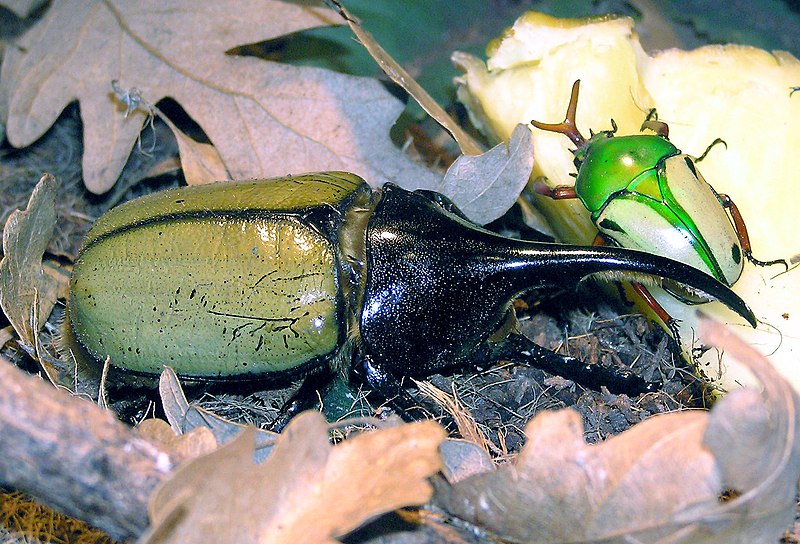 Beetle-keeping is a small but expanding hobby here in the USA, but is amazingly popular in Japan, where beetle larvae are even sold in vending machines (I experienced this first-hand, and can say they survive the ordeal quite well!). Beetles are classified in the order Coleoptera, which exceeds all other animal orders in species diversity, and they play a vital role most ecosystems. Beetle conservation, however, is in its infancy, so I was very pleased to learn of new efforts on behalf of the UK’s largest species, the European Stag Beetle, Lucanus servus.
Beetle-keeping is a small but expanding hobby here in the USA, but is amazingly popular in Japan, where beetle larvae are even sold in vending machines (I experienced this first-hand, and can say they survive the ordeal quite well!). Beetles are classified in the order Coleoptera, which exceeds all other animal orders in species diversity, and they play a vital role most ecosystems. Beetle conservation, however, is in its infancy, so I was very pleased to learn of new efforts on behalf of the UK’s largest species, the European Stag Beetle, Lucanus servus.
Elusive Quarry
The European Stag Beetle (please see photo) is likely in sharp decline, but no one knows why. They are very hard to study…adults do not feed and so cannot be lured to traps, and digging for buried larvae often kills them and destroys their habitat.
However, researchers at the Universities of London and York discovered that adult Stag Beetles are attracted to ginger, which releases a chemical (Alpha Copaene) known to attract wood-boring insects. Ginger-baited traps proved very effective.
Simultaneously, tiny microphones were used to detect the noises made beetle larvae as they moved about below ground or in dead wood (many invertebrates stridulate, or vibrate various body parts, in order to communicate). Instruments used to monitor pollution also proved useful in detecting the presence of Longifolene, a chemical released by beetle grubs.
Insect Conservation
Insect conservation is always overshadowed by efforts geared towards “cute and fuzzy” creatures (the “charismatic mega-vertebrates, as biologist call them)…in the UK, for example, Stag Beetle field studies rely almost entirely upon the efforts of dedicated volunteers. So I’m encouraged by these advances…with such technologies in place, it will be easier to study tiny, secretive creatures.
Giant Beetles in the Terrarium
I’ve always kept Caterpillar Hunters and other native beetles (please see article below), but it wasn’t until I began working at the Bronx Zoo that I met some of the most spectacular foreign species face-to-face. Charged with setting up an invertebrate display in the early 1980’s, I was astonished by the amazing range of beetles that was available. Helped along by a more experienced colleague, I was eventually able to rear and even breed some of the world’s largest and most impressive insects.
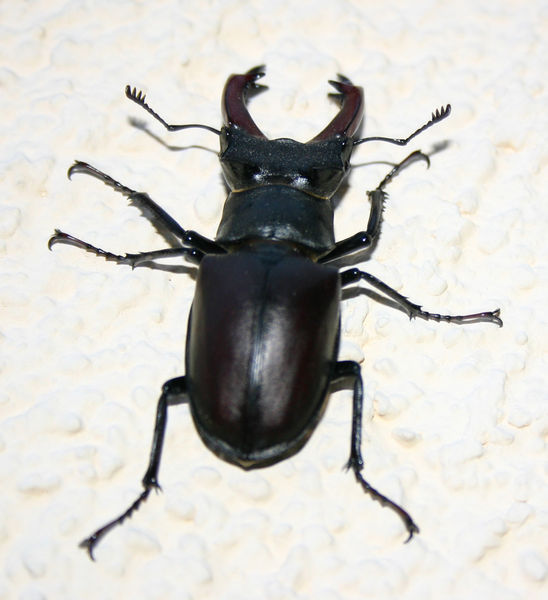 Some of these are occasionally available to private collectors in the USA, but imports are restricted. My favorites include the massive Goliath Beetle, Goliathus regius, the Hercules Beetle, Dynastes Hercules, and the Atlas Beetle, Chalcosoma atlas – all are well-named!
Some of these are occasionally available to private collectors in the USA, but imports are restricted. My favorites include the massive Goliath Beetle, Goliathus regius, the Hercules Beetle, Dynastes Hercules, and the Atlas Beetle, Chalcosoma atlas – all are well-named!
Today you can see quite a few beetles at the insect displays that are becoming ever more popular in US zoos. By all means make an effort to visit one – photos do not do these insect giants justice. The Cincinnati Zoo’s Insectarium tops my list, but even it pales in comparison to those I saw in Japan, where insect keeping has a long history…more on that in a future article.
Further Reading
European Stag Beetle image referenced from wikipedia and originally posted by Zylorian
 That Reptile Blog – Reptile, Amphibian and Exotic Pet Care and Information
That Reptile Blog – Reptile, Amphibian and Exotic Pet Care and Information

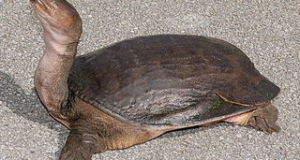
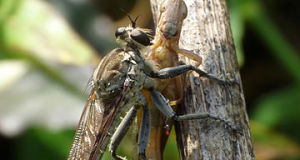
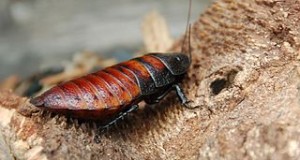
Hi Frank
I seem not to top your interests in wildlife…LOL.
I have two bug glass-display cupboards at home. There are a few bugs in there (mounted that is). But currently it is standing still for I do not seem to get time for all the cool things in life….
P.S. My sons and I caught a centipede to photograph for you but it still is in “custody” until we get time to take e few photos…
Coming to your European Stag Beetle, Lucanus servus. Here in Namibia we have a similar looking one except for its color is only dark brown all over. I therefore found it VERY interesting to learn that these guys do not eat!
Well, I’ll again try to search for another specimen then I can give some more info. It’s getting winter on our side so please do not expect and early reply on this one please!
Best regards once again!
Gert
Hello Gert, Frank Indiviglio here.
Don’t underestimate yourself!…you certainly have an amazing scope of interests! I see you have found our PetBlog as well, I’ll respond there shortly.
It’s very refreshing to see a real naturalist such as yourself these days; I’m the same – ants to elephants, plants, coral….this was common in the past, but no longer…I need to send you some book titles that may interest you, in case you haven’t seen them; many were written by folks exploring Africa – Ionides, Sanderson, etc.) Today even among professionals there is an overwhelming tendency to be ultra-specialised; I’ve run across mammal keepers (zoo) who could not tell a crab from a beetle, a PhD candidate who had worked with chimps in central Africa but did not know what an Okapi was!…so keep the notes coming.
Some stag beetles do feed as adults; offhand, I’m not sure about Africa’s native species, I’ll keep it in mind to check.
Please let me know if you need any further information. Good luck, enjoy and please keep me posted.
Best regards, Frank Indiviglio.
Hi Frank!! My favorite was Paul when I was a kid, but as I grew older, I started to really appreciate John!
All kidding aside, remember when Also had all of those Vinegaroons? (sp.) was that name derived from acid defense?
Hello Robert, Frank Indiviglio here.
Thanks for the note…as you know, I never appreciated any music that wasn’t made by bugs or frogs…terrible of me, I know! Yes, the Vingaroon’s name does come from their defense…and the first I saw close up were also at Aldo’s legendary store on 14th St., Fang and Claw! …
Best regards, Frank Indiviglio.
Dear Frank
Never saw such an creature in my life! Very interesting that Vingaroon bug/thingy! On the internet it look like it is a insect with eight legs??? Or is it a spider(can not imagine)
It resembles very much the “Nepa cinerea” or water scorpion we have got here in our waters…
Is the “vinegar” it sprays, coming out of its tail?
Sorry for changing the subject!
Best regards
Gert
Hello Gert, Frank Indiviglio here.
Thanks…they really are “other-worldly”, aren’t they? They are arachnids, likely a link in spider-scorpion evolutionary chain but relationships not well-studied. Vinagaroons have very unique glands along the abdomen for spraying; amazing for what are considered “primitive” creatures!
Water scorpions are insects, although it’s hard to tell; I’ve never seen any African species, thanks, I’m interested in looking into them a bit, fascinating little beasts.
Please let me know if you need any further information. Good luck, enjoy and please keep me posted.
Best regards, Frank Indiviglio.
Sorry Frank
I was a bit confused! I now found that the “tailless whip scorpions” or “Amblypygi” is belonging to the Arachnids as well as the “vinegaroons” or “Thelyphonida”
The “water scorpion” or “Nepidae” on the other hand is a solid insect!
Best regards as always
Gert
Hello Gert, Frank Indiviglio here.
Thanks…common names vary and are confusing; you have it right. We have some small water scorpions here in the US, not uncommon but usually escape notice as well-camouflaged. They behave somewhat like an “aquatic mantid”, remaining very still until prey comes close, and then striking out with the forelimbs just like a mantid. I exhibit a few in a public aquarium, quite a hit with visitors who took the time to find them.
Please let me know if you need any further information. Good luck, enjoy and please keep me posted.
Best regards, Frank Indiviglio.
At the moment, i’m keeping some fruit beetles. The larvae were actually brought as food for my Bearded dragon, but were far too vicious! We kept the larva and now have a breeding group.
They are very very easy to keep and make brilliant pets for schools – few costs, minimum care and a brilliant way to look at incomplete metamorphosis in action.
Hello, Frank Indiviglio here.
Thanks for the most interesting post; great idea, I’m always interested in new species that I can recommend to schools and nature centers, thanks. Were the larvae aggressive?
Do you have a Latin name or link to a photo…several different species are commonly referred to as fruit beetles here in the US. Thanks,
Good luck, enjoy and please keep me posted.
Here is a link for the species that I have: http://en.wikipedia.org/wiki/Pachnoda_marginata
They are a common reptile food in the UK and very aggressive as larvae. They seem to breed very easily. I’ve just supplied them with a small tank, soil substrate, some leaf litter (for the larvae to feed from, they also eat dog biscuits!) and bits of fruit for the adults. Usually they eat the fruit pretty quickly, but I remove it ever couple of days to prevent any fruit fly infestations.
Hello, Frank Indiviglio here.
Thanks very much for the info. I’ve kept relatives as exhibit animals in zoo, but have not seen that species offered here; US dept. of Agriculture very strict on herbivorous insect importations, even for zoos. I’ve always meant to investigate similar native species, maybe soon…
I look forwards to hearing more from you in the future.
Good luck, enjoy and please keep me posted.
Best regards, Frank Indiviglio.
I live in Michigan, and this is the second year I have accidently came across these amazing stag beetles. I believe the first time 2 years ago was a female, and tonight was a male as he raised up to display himself and moved around me,lol. I also believe based on pictures of their larvea, they are breeding in my garden. What an honor, although the scare the beegezus out of my husband and kids. I explained to them that they are special and not to be killed. I wish I had my camera available, hopefully I will see them again, I am sure I will.So all in all, they are alive and well here in Michigan and apparently like my yard.
Hello, I just found a beetle that looks like the giant black one shown above. He is 1-1/2″ long. Is this rare?
Hello,
There are many similar species (the beetle family has more species than any other animal family) and rarity depends upon many factors. Where did you find it? best, frank
Found him in Maryland near a creek. A lady from the UK thinks it could be a pinching bug. I’ll send you a pic of it. Pls. email me so I can reply with a pic for you. It really looks like your pic above, however. Should I release it?
Hi,
Pl email to findiviglio@thatpetplace.com
Best, Frank